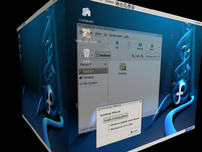
- Image via Wikipedia
We continue to want to write about Fedora, especially in light of our recent inspiration. We were reading this post on a blog about the fact that Fedora 11 will have roughly 60 new features, some of which we previously summarized. The last few releases have had less than half that. Today is the feature freeze for Fedora 11.
The author predicts these features will have other distributions rushing to catch up. The beta freeze of F11 is in a week, with the Beta release on the 24th. The final release is set for the end of May.
Every time there is a new release of Fedora coming, we wipe and reinstall every system from scratch. Our preparations begin a month in advance, when we start mirroring the complete Fedora repository and the update repository for the release, as well as our favorite 3rd-party repositories. Every night, a cron job updates any changes made.
Jigdo allows us to use those files to assemble an install image. And we maintain the repository and keep it updated to keep our systems updated. As we mentioned previously, the new DeltaRPM system will save download bandwidth.
Creating a local repository is easy. You start with your installation DVD, if you have one, and copy the packages to a directory. Then, run the createrepo command on the directory(you may have to install it). The directory should be accessible on a local web server…we use lighttpd over apache for memory reasons(but more on that another time). Then, you can edit your yum configuration files in one of two ways…adding a local only repository file, or editing the existing files to redirect to the local server instead of one of the Fedora mirrors.
To sync a remote update use a command like this…
rsync -avrt rsync://mirrorsite/fedora/linux/releases/10/updates/x86_64/ /var/www/html/yum/updates/10/x86_64
Go to the Fedora Mirror List to find mirrors that work for you.
As a final step, the Fedora Unity project releases re-spins of the Fedora releases with updated packages, as well as the Fedora Everything spin, which is a multiple DVD release of the entire Fedora repository.
With hard drive space so cheap lately, and metered internet coming into vogue, this is a decent solution. Once one has the latest distribution, one has to figure out how to distribute it to multiple systems. We start by loading it onto one system, and breaking it in before distributing it elsewhere.
More to come…


![Reblog this post [with Zemanta]](http://img.zemanta.com/reblog_e.png?x-id=bf7edfec-3be4-433b-a588-9b6e6d13f943)





![Reblog this post [with Zemanta]](http://img.zemanta.com/reblog_e.png?x-id=00fd589d-12e2-480c-b3bd-9c796ad6595a)
![Reblog this post [with Zemanta]](http://img.zemanta.com/reblog_e.png?x-id=5ff9a636-8774-44f0-8ee6-d9c6a9a4f7c2)

![Reblog this post [with Zemanta]](http://img.zemanta.com/reblog_e.png?x-id=36b1052e-27ed-49e1-913c-d6f9c005fe4f)


![Reblog this post [with Zemanta]](http://img.zemanta.com/reblog_e.png?x-id=9cc822b5-a56e-4f39-84a9-285f4148dda7)
![Reblog this post [with Zemanta]](http://img.zemanta.com/reblog_e.png?x-id=64de604d-d1dc-48e1-aa7b-80156409e4d2)


![Reblog this post [with Zemanta]](http://img.zemanta.com/reblog_e.png?x-id=747260c7-bcb6-40bb-8d0b-b11676719cb7)


![Reblog this post [with Zemanta]](http://img.zemanta.com/reblog_e.png?x-id=df414f6d-527d-45f2-9ac5-fe3a4fd54312)
![Reblog this post [with Zemanta]](http://img.zemanta.com/reblog_e.png?x-id=66e04412-d5d4-4e4c-8b45-60330c6f62c6)